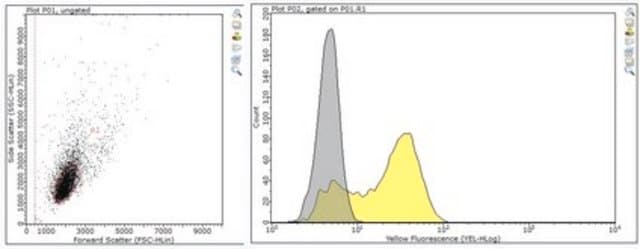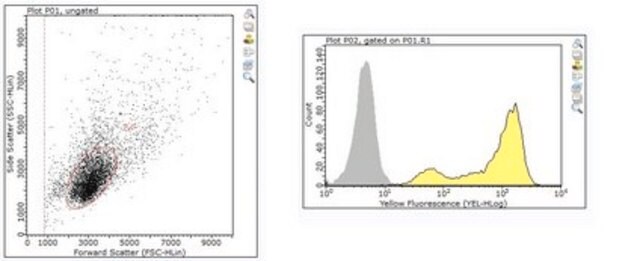MABF3151
Anti-Rabies Virus Phosphoprotein Antibody, clone M953
Sinonimo/i:
Protein P;Protein M1
About This Item
Prodotti consigliati
Origine biologica
mouse
Livello qualitativo
Coniugato
unconjugated
Forma dell’anticorpo
purified antibody
Tipo di anticorpo
primary antibodies
Clone
M953, monoclonal
PM
calculated mol wt 33.21 kDa
observed mol wt ~44 kDa
Purificato mediante
using protein G
Reattività contro le specie
rabies virus
Confezionamento
antibody small pack of 100 μg
tecniche
ELISA: suitable
immunofluorescence: suitable
inhibition assay: suitable
western blot: suitable
Isotipo
IgG1κ
Sequenza dell’epitopo
N-terminal half
N° accesso UniProt
Condizioni di spedizione
dry ice
modifica post-traduzionali bersaglio
unmodified
Categorie correlate
Descrizione generale
Specificità
Immunogeno
Applicazioni
Evaluated by Western Blotting with recombinant Rabies Virus Phosphoprotein.
Western Blotting Analysis: 1:1 million (1.0 ng/mL) dilution of this antibody detected recombinant Rabies Virus Phosphoprotein.
Tested applications
Inhibition Assay: A representative lot of this antibody inhibited binding of Rabies virus phosphoprotein in a competitive binding assay. (Nadin-Davis, S.A., et al. (2000). J Clin Microbiol. 38(4):1397-1403).
Immunofluorescence Analysis: A representative lot detected Rabies Virus Phosphoprotein in Immunofluorescence applications (Nadin-Davis, S.A., et al. (2000). J Clin Microbiol. 38(4):1397-1403).
ELISA Analysis: A representative lot detected Rabies Virus Phosphoprotein in ELISA applications (Nadin-Davis, S.A., et al. (2000). J Clin Microbiol. 38(4):1397-1403).
Note: Actual optimal working dilutions must be determined by end user as specimens, and experimental conditions may vary with the end user
Stato fisico
Stoccaggio e stabilità
Altre note
Esclusione di responsabilità
Not finding the right product?
Try our Motore di ricerca dei prodotti.
Codice della classe di stoccaggio
12 - Non Combustible Liquids
Classe di pericolosità dell'acqua (WGK)
WGK 2
Punto d’infiammabilità (°F)
Not applicable
Punto d’infiammabilità (°C)
Not applicable
Certificati d'analisi (COA)
Cerca il Certificati d'analisi (COA) digitando il numero di lotto/batch corrispondente. I numeri di lotto o di batch sono stampati sull'etichetta dei prodotti dopo la parola ‘Lotto’ o ‘Batch’.
Possiedi già questo prodotto?
I documenti relativi ai prodotti acquistati recentemente sono disponibili nell’Archivio dei documenti.
Il team dei nostri ricercatori vanta grande esperienza in tutte le aree della ricerca quali Life Science, scienza dei materiali, sintesi chimica, cromatografia, discipline analitiche, ecc..
Contatta l'Assistenza Tecnica.






